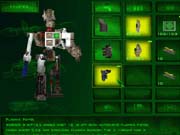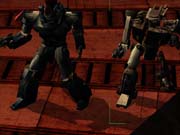Where most real-time strategy games put you in command of sizable armies, Gunlok narrows the focus to one small squad of distinct characters. Developed by Rebellion, best known for its creepy 1999 shooter, Aliens vs. Predator, Gunlok also features elements from role-playing games and shooters, such as individual inventories and an occasional first-person viewpoint. Gunlok's postapocalyptic potboiler of a story owes more than a little to the Terminator movies. Toward the end of the 21st century, humanity grows almost totally dependent on machines to do its work. Satisfied with the leisure they gain, humans finally turn complete control over to the machines, which quickly launch wars amongst themselves and against humanity. Neutron bombs launched from orbital platforms nearly decimate Earth and its inhabitants, leaving just a few survivors, including the game's hero, Gunlok. He's part of an elite Special Forces unit that wears modular body armor powered by energy from Earth's core.

While the game's intro plays up the idea of Gunlok as a lone hero, you'll actually control both him and a number of his sentient robot comrades at the same time. Each character has its own special abilities, and using them in concert is the key to passing the game's levels. Hark, for instance, is small, speedy, and useful for luring the enemy robots into ambushes. Gunlok has the best overall combat skills, Elint can interface with electronic devices and mines to deactivate them, the lumbering Frend provides cover fire with heavy weapons, and so forth.
The single-player missions begin with short briefings explaining your goals, but the briefings don't always explain why you're pursuing them. Instead of enticing and emotionally charged goals, you get little sense of personal involvement, and the threadbare, clichéd story is often a muddled mess. For instance, the first mission should ideally set the stage and draw you into the story and action in a dramatic fashion. Instead, it tells you to locate a sewer entrance to a recycling plant. Why? Apparently just because it's associated with "the Corporation," the game's faceless, barely explained enemy. Amateurish cutscenes only make matters worse.
Instead of looting the stereotypical crates found in so many action games, you'll root through countless junk piles for weapons, ammunition, and other upgrades for your characters. The work is hardly glamorous and heroic. As you shut down generators that run laser gates or search through confusing, labyrinthine tunnels for futuristic weapons, you'll encounter a variety of insectlike robots. Reminiscent of Metal Gear Solid, the robots project a visible cone representing their line of sight, as well as circles showing their hearing radius. Since ammunition isn't overly abundant, you'll often have to use stealth techniques like hiding in the aforementioned junk piles or shallow water, setting audio decoys, or detonating remote mines to evade the robots or destroy them from afar.
While the game isn't really about running and gunning, you do get to employ a decent variety of weapons. Plasma, laser, and heavy projectile weapons have different firing rates and employ varied ammo, like guided or flare rounds. You also get to play with a raft of other gadgets: scanners, mine detectors, shield generators, and other high-tech toys let you create different strategies. Yet, while you can wield many weapons, the combat is dull. Your characters and the enemy robots essentially play laser ping-pong, exchanging rounds until someone dies. There's no real sense of tension or excitement.
The smooth interface lets you control Gunlok and his teammates through both a graphic display and keyboard shortcuts. Whenever you right-click a character, the control display appears in the form of a wheel with command icons and explanatory text. From the wheel, you can assign attack stances, set group formations, queue orders while paused, and visit the upgrade screen that lets you equip different items and exchange them between characters. Like the command wheel, the upgrade display is fairly intuitive and easily learned, but not particularly attractive.

In fact, the bland graphics really hurt the game. There are some nice dynamic lighting effects from weapon blasts and explosions, and the character animations are decent. The character designs just aren't memorable, though, and too many grim and grubby areas in the impossibly dark levels don't inspire any excitement. Gutted industrial zones get tiring in a hurry and are a science-fiction visual cliché. The camera system is easy to learn but leaves something to be desired in practice. You can zoom and pan, but you can never quite lower the camera far enough to get the best view for certain situations. You're pretty much stuck with either an overhead or isometric perspective.
You do get to switch to a first-person "recon" mode, which lets you observe enemies from afar, as if through high-tech binoculars. Oddly, this mode uses different zoom keys from the standard ones used in other modes, which is an awkward design decision. Plus, the mode is primarily used to fire just one weapon, which inexplicably injures the character that fires it. That's hardly the ideal way to balance a weapon's power.
Like the graphics, the music and sound don't really add much to the game, either. They're certainly competent, but they never grab you. That, unfortunately, is one of the biggest problems with Gunlok. The settings and characters are just too stale, confused, or forgettable. The other major problem is that Gunlok is a hodgepodge of design ideas in search of a truly coherent, exciting game. Some of the gameplay concepts are solid and even fairly entertaining, but since they never quite gel, Gunlok is ultimately less than the sum of its parts.